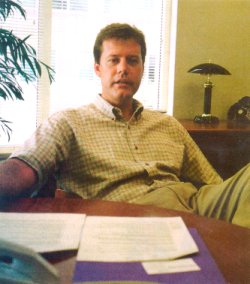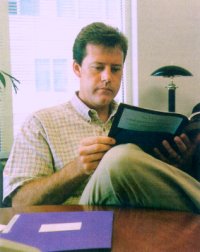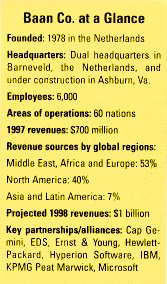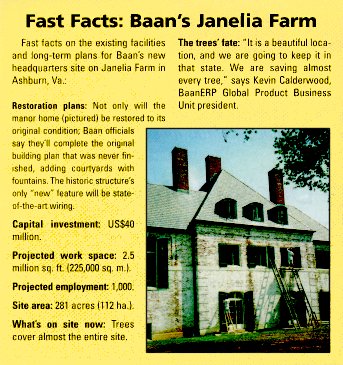|
|
Baan’s Battle with Skyrocketing Space Demands
Baan’s big U.S. move coincides with a number of key challenges, most based in blur-like growth. But business climate factors augur well for the software giant’s $40 million Virginia project.
“We leased this space about six months ago, and already we are stacking on top of each other,” adds Calderwood, president of the BaanERP Global Product Business Unit. “The way we are growing, we are just lucky to have a seat for somebody.” Such autobahn-speed real estate challenges are new to Baan, founded in the Netherlands in 1978. From 1993’s 900 employees, Baan has exploded to 6,000 employees in 60 nations. But the solution for Baan’s U.S. space crunch is something old, very old, a three-story Normandy-style manor house and an adjacent carriage house on Ashburn, Va.’s Janelia Farm, a tree-lined, 281-acre (112-ha.) tract with Potomac River frontage. That land will centralize Baan’s burgeoning U.S. operations, serving as one arm of its “dual headquarters,” along with Baan’s Netherlands base in Barneveld. “Baan is the rising star of the enterprise resource-planning (ERP) software industry,” says PC Week. For such high-tech mavens, run-of-the-mill real estate won’t do. Listed on the National Historic Register, Janelia Farms’ facilities are anything but ordinary.
“We are relocating a lot of people from Europe. The Loudoun County location provides a very good quality of life for Europeans, who like this kind of country-type setting rather than in, say, downtown New York City.”
Holland’s U.S. Opus
The big Virginia investment underscores Baan’s intent.
But Baan’s big U.S. move coincides with several key corporate challenges. Chief among them: a top management shakeup, a style that still puzzles part of the U.S. investment community and Baan’s pivotal hookup to develop “the digital nervous system” with Microsoft. “Baan has made the strongest Microsoft-centric commitment among ERP vendors,” says Meta Group analyst Barry Wilderman. To varying degrees, all those issues are playing out in Baan’s real estate challenges.
Working on Global Time Originally, Baan’s U.S. operations were based in Menlo Park, Calif. The business climate factors that prompted the move mirror the project’s mission-critical nature. “Initially, we needed a presence in Silicon Valley, which was also home to the legal and banking teams that took us public in 1995,” Calderwood explains. As its U.S. presence snowballed, though, Baan began to question basing U.S. operations in the fabled Silicon Valley. In 1996, it quietly began a nationwide search. Baan’s list of finalists reflects one major location issue: time. In addition to California, that list included Massachusetts, Michigan, New Jersey and Virginia — all in the U.S. Eastern time zone. “It is much more efficient to be in Virginia from a time standpoint,” Calderwood says. “When California is waking up, Europe is ready to go to sleep. Here, the business day overlaps with Europe. We can still communicate back and forth, so we start the day at 5, 6 or 7 a.m.” The area’s three international airports also provide far faster travel to Europe, he adds.
What Virginia offered was a fertile high-tech business climate. The state has quietly become a world center for software, Internet, telecom and satellite technologies (all, not coincidentally, converging). Virginia now is No. 9 in high-tech employment among U.S. states. That high-tech presence is particularly striking in Northern Virginia, which boasts the largest U.S. concentration of computer companies, including the headquarters of Alcatel Data Network, America OnLine, Landmark Systems, Orbital Sciences and UUNet Technologies. Northern Virginia’s high-tech cluster comprises only 3 percent of total area businesses, but produces one-fourth of private-sector earnings and 16 percent of total employment. “We can be proud of the explosion in tech companies, tech jobs and tech wages,” says Landmark Systems CEO Kathy Clark, chairwoman of the Northern Virginia Technology Council. Northern Virginia’s business climate also met another key location requirement: a deep pool of high-skill workers. “The No. 1 challenge for rapid-growth technology companies like Baan is finding qualified, quality people,” Calderwood says. “This is a very good area for such resources, with many qualified, efficiently trained technology workers. And since many do government projects, a flood of people becomes available when those projects end.” Northern Virginia also solved an endemic high-tech problem: astronomical turnover. “There’s a Silicon Valley joke: You have to find a headhunter to find you a headhunter to find some people,” Calderwood explains. “We manufacture intellectual property; our value proposition is employees’ intellectual property. We can’t afford to have employees work for us one day and a competitor the next. That escalates constantly in Silicon Valley, creating a very unhealthy environment to grow a stable, quality company. Here, employees have more loyalty.” Baan, however, hasn’t abandoned the Silicon Valley, the birthplace of Aurum Software, which Baan acquired in 1997. Aurum’s sales force automation system has been a major factor in Baan’s penetration of the deep Windows-based ERP market. In fact, Baan moved its California base from Menlo Park to Santa Clara, home base for Aurum, which wanted to keep its local technology vendors. “Much of our product development and global product management is based in Santa Clara,” Calderwood says. “We will always have a significant Silicon Valley presence.”
Baan’s Global Designs Founded in the Netherlands, a country of 15 million people, Baan’s going global was a necessity. As a software giant, Baan goes global by choice. With ERP’s rapid mid-market growth, opportunity is knocking. The global ERP sector will grow from 1997’s $7.2 billion to $19 billion-plus by 2001, according to Advanced Manufacturing Research. Those numbers have Baan’s global location engines revving at mach-speed. It has a host of projects on tap, including a Latin American support center in Sao Paulo, Brazil; a German-language support center in Duisburg, Germany; an English-speaking Asia-Pacific support center in Kuala Lumpur, Malaysia; a Japanese support center and a global support center in Hyderabad, India. “We are also looking at new countries in emerging markets, some in the Asia-Pacific,” Calderwood says. European business climate changes are also boosting Baan’s fortunes. With the Jan. 1, 1999, exchange rate freeze, the 11-nation “Eurozone” will effectively share the same currency. That will trigger uniform pricing and greater pan-European competition, forcing radical supply-chain restructuring, says Ralph Baer, UK-based Druid’s principal Euro consultant. That’s a boon for Baan. Its savvy 1996 acquisition of Canadian software vendor Berclainl appreciably strengthened its supply-chain offerings. Shared Space and New Hubs Calderwood is candid about Baan’s real estate practices. For fast-growth firms like Baan, speed often outranks systems. Nonetheless, Baan is adopting many leading-edge real estate strategies. “We are thinking through U.S. shared offices, especially for people who travel,” Calderwood says. “Rather than one office for each consultant, who should be in the field four days a week, we might have one for 10-15 consultants. They can use a shared office as their station for that day.” Thus far, Baan has handled its rapid growth through short-term leasing. “Now, we are looking at long-term real estate strategies in areas in which we have a critical mass, where we might purchase,” Calderwood says. Part of Baan’s strategy is creating a series of U.S. hubs, including Milwaukee, Detroit, Dallas, Los Angeles and Seattle, he says. ‘Hire Quality, Not Location’ “We use all technologies that allow global companies to communicate,” Calderwood explains. “We have some people working out of their homes; our goal is to hire top-caliber people, not locations. We link them, plus all field operations, via intranets and e-mail. All major offices have videoconferencing, and many employees have video cameras on their PCs to talk to people worldwide.” Plugged-in work space also strengthens Baan’s development and support, he adds. “The development group is tied to a very fast network that allows real time source-code access. We do distributive development almost around the clock. As developers in India go to sleep, for instance, the code is refreshed, so the next time zone’s group works on the latest code. “And our major support sites in Barneveld, Grand Rapids, Mich., and Mumbai, India, are linked and rotate through time zones. One is always working if customers have problems.” The Microsoft Hookup “Baan is a great ally,” Microsoft Chairman Bill Gates told the BaanWorld conference on Apr. 21 (the same day Microsoft lawyers opened their winning argument against the U.S. Justice Dept.). The partnership only began in September of 1997. But already Baan products for the Windows NT platform account for 35 percent of licensing sales and will likely top $180 million for 1998. Shared space enables Baan and Microsoft to coordinate product development and release. “We have relocated people to Microsoft’s headquarters in Redmond, Wash., and they have relocated people to Barneveld,” Calderwood says. “It is a tremendous relationship.” Challenges and Leadership One revolves around Baan Investment (BI), which founding brothers Jan and Paul Baan set up in 1993 as the first in-house ERP venture fund. BI was overseen by Oikonomos, the Baan family’s nonprofit foundation, valued at $2.4 billion. While the foundation will donate $10 million-plus to charity this year, some financial analysts feel its relationship to Baan has clouded reported earnings. Baan clarified matters somewhat in July, changing Baan Investment’s name to Vanenburg Ventures (VV), which is divesting itself of several major Baan businesses. “That’s a step in the right direction,” says Salomon Smith Barney analyst Neil Herman. But VV still owns The Baan Institute, part of Baan’s Virginia headquarters project, he adds. July also saw Jan Baan resign as Baan chairman (though he remains on the supervisory board), while Paul Baan left the company to focus on Vanenburg Ventures. And in first-quarter 1998 Baan failed to comply with new U.S. Securities and Exchange Commission (SEC) revenue guidelines. “Europeans tend to understand what we do,” says Tinsley. “But we must be more clear, since Americans are more obsessed with accounting.” Despite the brouhaha, Baan still sails along. Reported second-quarter 1998 revenues of $230 million marked a 46 percent increase (and met SEC standards), pointing toward Baan’s first $1 billion year. Calderwood reflects both Baan’s bullishness and its unconventional approach:
|
| SS Online | SiteNet |
Feedback |
GeoSearch |
©1998 Conway Data, Inc. All rights reserved. SiteNet data is from many sources and is not warranted to be accurate or current.


 OCTOBER/NOVEMBER 1998
OCTOBER/NOVEMBER 1998 “We’ re going to divide this office and the conference room into cubicles,” says Baan Co.’s Kevin Calderwood, sitting in Reston, Va., in what, for the moment, is his office.
“We’ re going to divide this office and the conference room into cubicles,” says Baan Co.’s Kevin Calderwood, sitting in Reston, Va., in what, for the moment, is his office.  “One of the big reasons we chose to move to Virginia is that our culture fits the site’s history,” Calderwood says. “Baan is not a glass high-rise along a freeway. We highly value historic significance. In the Netherlands, we renovated a 17th-century castle surrounded by a moat, which provides a different, distinctive quality-of-life environment.
“One of the big reasons we chose to move to Virginia is that our culture fits the site’s history,” Calderwood says. “Baan is not a glass high-rise along a freeway. We highly value historic significance. In the Netherlands, we renovated a 17th-century castle surrounded by a moat, which provides a different, distinctive quality-of-life environment.  First-phase site development will house 400 employees in 550,000 sq. ft. (49,500 sq. m.) of office and R&D facilities, including The Baan Institute, an employee educational center. Within three to five years, Baan plans a 2.5-million-sq.-ft. (225,000-sq.-m.), $40 million base with 1,000 employees.
First-phase site development will house 400 employees in 550,000 sq. ft. (49,500 sq. m.) of office and R&D facilities, including The Baan Institute, an employee educational center. Within three to five years, Baan plans a 2.5-million-sq.-ft. (225,000-sq.-m.), $40 million base with 1,000 employees. A Deep High-Tech Pool
A Deep High-Tech Pool